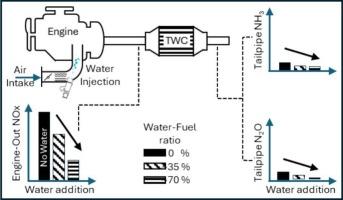Abating secondary NH3 and N2O formation on the three-way catalysts: The role of steam
IF 7.5
1区 工程技术
Q2 ENERGY & FUELS
引用次数: 0
Abstract
Even though water injection has already been proven to reduce NOx formation within the combustion chamber, there is limited research on how this affects the formation of such emissions in three-way catalysts (TWCs). Considering this, the work presented here studies the effect of in-cylinder water injection on the performance of a TWC with respect to the formation of ammonia (NH3) and nitrous oxide (N2O). Experimental testing using a gasoline direct injection (GDI) engine fitted with an intake port water injection system was completed. These tests found a clear reduction in NH3 formation over the TWC when in-cylinder water injection was implemented. The reduction in NH3 formation, particularly pronounced at richer conditions, is attributed to lower engine-out NO concentrations, which in turn reduces secondary NH3 formation over the TWC. Lean engine conditions did not produce any NH3 with or without water injection, due to lower TWC NH3 selectivity. There was minimal formation of N2O during this work as the TWC temperature was greater than the typical N2O formation window. This work highlights the synergistic benefits of reducing secondary emissions during the combustion process and the favourable effect on catalytic technologies through in-cylinder water enrichment.

抑制三元催化剂上NH3和N2O的二次生成:蒸汽的作用
尽管注水已经被证明可以减少燃烧室内NOx的形成,但关于注水如何影响三元催化剂(twc)中NOx排放的研究仍然有限。考虑到这一点,本文研究了缸内注水对TWC性能的影响,包括氨(NH3)和氧化亚氮(N2O)的形成。在装有进气口注水系统的汽油直喷发动机上完成了试验测试。这些测试发现,当缸内注水时,TWC上的NH3形成明显减少。NH3形成的减少,特别是在较富条件下,归因于较低的发动机输出NO浓度,这反过来又减少了TWC上二次NH3的形成。由于较低的TWC NH3选择性,无论是否注水,精益发动机条件下都不会产生任何NH3。由于TWC温度大于典型的N2O形成窗口,因此在此工作期间N2O的形成很少。这项工作强调了在燃烧过程中减少二次排放的协同效益,以及通过缸内水富集对催化技术的有利影响。
本文章由计算机程序翻译,如有差异,请以英文原文为准。
求助全文
约1分钟内获得全文
求助全文
来源期刊

Fuel
工程技术-工程:化工
CiteScore
12.80
自引率
20.30%
发文量
3506
审稿时长
64 days
期刊介绍:
The exploration of energy sources remains a critical matter of study. For the past nine decades, fuel has consistently held the forefront in primary research efforts within the field of energy science. This area of investigation encompasses a wide range of subjects, with a particular emphasis on emerging concerns like environmental factors and pollution.
 求助内容:
求助内容: 应助结果提醒方式:
应助结果提醒方式:


